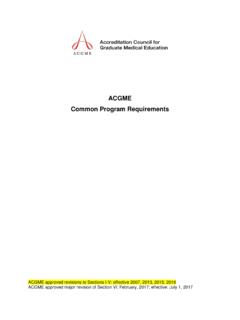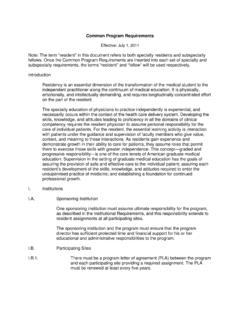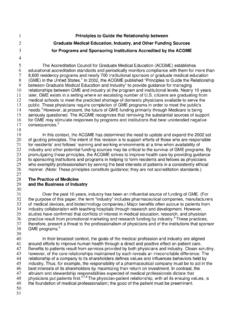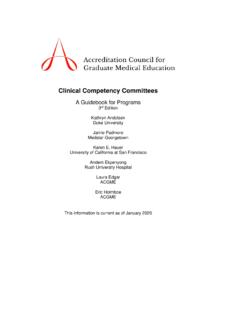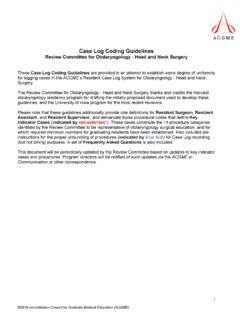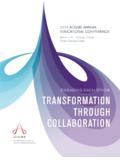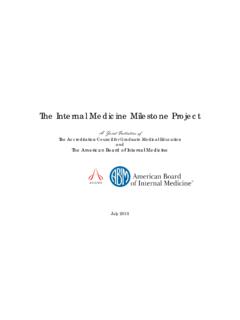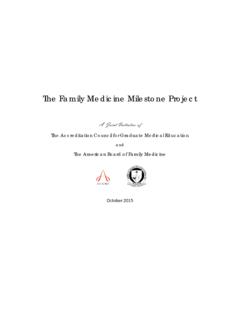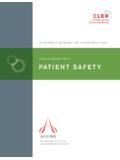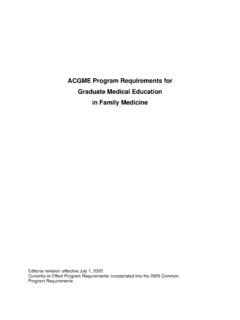Transcription of Common Program Requirements - acgme.org
1 acgme Program Requirements for graduate medical education in Family Medicine Proposed major revision; posted for review and comment on December 13, 2021 Family Medicine for Review and Comment 2021 accreditation council for graduate medical education ( acgme ) Page 2 of 74 Contents Introduction .. 3 Preamble .. 3 Definition of Specialty .. 3 Length of Educational Program .. 5 I. Oversight .. 5 Sponsoring Institution .. 5 Participating Sites .. 5 Recruitment .. 6 Resources .. 7 Other Learners and Other Care Providers .. 11 II. Personnel .. 11 Program Director .. 11 Faculty .. 16 Program Coordinator .. 21 Other Program Personnel .. 22 III. Resident Appointments .. 22 Eligibility Requirements .. 22 Number of Residents .. 24 Resident Transfers .. 24 IV. Educational Program .. 24 Curriculum Components .. 25 acgme Competencies .. 26 Curriculum Organization and Resident Experiences.
2 35 Scholarship .. 43 V. Evaluation .. 45 Resident Evaluation .. 45 Faculty Evaluation .. 50 Program Evaluation and Improvement .. 51 VI. The Learning and Working Environment .. 55 Patient Safety, Quality Improvement, Supervision, and Accountability .. 55 Professionalism .. 61 Well-Being .. 63 Fatigue Mitigation .. 66 Clinical Responsibilities, Teamwork, and Transitions of Care .. 67 Clinical Experience and education .. 68 Family Medicine for Review and Comment 2021 accreditation council for graduate medical education ( acgme ) Page 3 of 74 1 acgme Program Requirements for graduate medical education 2 in Family Medicine 3 4 Common Program Requirements (Residency) are in BOLD 5 6 Where applicable, text in italics describes the underlying philosophy of the Requirements 7 in that section. These philosophic statements are not Program Requirements and are 8 therefore not citable. 9 10 Introduction 11 12 graduate medical education is the crucial step of professional 13 development between medical school and autonomous clinical practice.
3 It 14 is in this vital phase of the continuum of medical education that residents 15 learn to provide optimal patient care under the supervision of faculty 16 members who not only instruct, but serve as role models of excellence, 17 compassion, professionalism, and scholarship. 18 19 graduate medical education transforms medical students into physician 20 scholars who care for the patient, family, and a diverse community; create 21 and integrate new knowledge into practice; and educate future generations 22 of physicians to serve the public. Practice patterns established during 23 graduate medical education persist many years later. 24 25 graduate medical education has as a core tenet the graded authority and 26 responsibility for patient care. The care of patients is undertaken with 27 appropriate faculty supervision and conditional independence, allowing 28 residents to attain the knowledge, skills, attitudes, and empathy required 29 for autonomous practice.
4 graduate medical education develops physicians 30 who focus on excellence in delivery of safe, equitable, affordable, quality 31 care; and the health of the populations they serve. graduate medical 32 education values the strength that a diverse group of physicians brings to 33 medical care. 34 35 graduate medical education occurs in clinical settings that establish the 36 foundation for practice-based and lifelong learning. The professional 37 development of the physician, begun in medical school, continues through 38 faculty modeling of the effacement of self-interest in a humanistic 39 environment that emphasizes joy in curiosity, problem-solving, academic 40 rigor, and discovery. This transformation is often physically, emotionally, 41 and intellectually demanding and occurs in a variety of clinical learning 42 environments committed to graduate medical education and the well-being 43 of patients, residents, fellows, faculty members, students, and all members 44 of the health care team.
5 45 46 Definition of Specialty 47 48 49 Family physicians are generalists who care for diverse individuals in the context 50 of their families and communities through accessible, comprehensive, 51 Family Medicine for Review and Comment 2021 accreditation council for graduate medical education ( acgme ) Page 4 of 74 continuous, and coordinated care. They provide empathic, compassionate, 52 equitable, culturally humble, and relationship-based care to their patients of all 53 ages and life stages in a wide variety of settings. 54 55 As routinely the first contact for medical care, family physicians seek to 56 understand and address the undifferentiated problems and health goals of 57 patients. They have expertise in managing complexities and are able to address 58 multiple co-morbidities through coordinated interdisciplinary and interprofessional 59 care. They are advocates for high-quality, cost-effective care providing high value 60 to improve health outcomes and the patient experience, and to reduce care 61 costs.
6 Family physicians work to integrate knowledge of the structural 62 determinants of health to advance equity in health and health care for all. 63 64 Family physicians provide care within the context of their patients families and 65 community, often caring for multigenerational members of the same family. This 66 opportunity for contextual care gives family physicians an important perspective 67 for understanding barriers to health. They use critical thinking skills in the service 68 of understanding the patient illness experience to arrive at a Common shared 69 therapeutic approach. 70 71 Family physicians are skilled in behavioral health, seeing the whole person and 72 recognizing the breadth of unmet behavioral health needs in an increasingly 73 complex society. 74 75 Family physicians excel at coordinated team-based care and are values-driven 76 advocates of efficient care through their membership on diverse, 77 interprofessional teams. They are superb communicators and serve as teachers 78 to patients, colleagues, and community groups.
7 They employ respect and 79 compassion with colleagues and teams, as well as with patients and their 80 families. They embrace the concept of team care as members and leaders of the 81 multiple teams required to provide complex and coordinated care. 82 83 Family physicians engage in self-reflection as master adaptive learners who 84 continually assess professional development needs. 85 86 Family physicians are social justice advocates for their patients and their 87 communities, engaging in health policy and local organizations, as appropriate, 88 to voice and mitigate the impact of structural social determinants on health 89 outcomes. They understand complex health issues and apply ethical principles to 90 health care decisions as they care for diverse patient populations with diverse 91 value structures within an unequal medical system. 92 93 Family physicians critically analyze and appropriately apply technology to provide 94 better and more personal clinical care.
8 95 96 Family medicine is a primary care specialty which demonstrates high quality care 97 within the context of a personal doctor-patient relationship and with an 98 appreciation for the individual, family, and community connections. Continuity of 99 comprehensive care for the diverse patient population family physicians serve is 100 foundational to the specialty. Access, accountability, effectiveness, and efficiency 101 are essential elements of the discipline. The coordination of patient care and 102 Family Medicine for Review and Comment 2021 accreditation council for graduate medical education ( acgme ) Page 5 of 74 leadership of advanced primary care practices and evolving health care systems 103 are additional vital roles for family physicians. (Core)* 104 105 Length of Educational Program 106 107 The educational Program in family medicine must be 36 months in length. (Core)* 108 109 I. Oversight 110 111 Sponsoring Institution 112 113 The Sponsoring Institution is the organization or entity that assumes the 114 ultimate financial and academic responsibility for a Program of graduate 115 medical education , consistent with the acgme Institutional Requirements .
9 116 117 When the Sponsoring Institution is not a rotation site for the Program , the 118 most commonly utilized site of clinical activity for the Program is the 119 primary clinical site. 120 121 Background and Intent: Participating sites will reflect the health care needs of the community and the educational needs of the residents. A wide variety of organizations may provide a robust educational experience and, thus, Sponsoring Institutions and participating sites may encompass inpatient and outpatient settings including, but not limited to a university, a medical school, a teaching hospital, a nursing home, a school of public health, a health department, a public health agency, an organized health care delivery system, a medical examiner s office, an educational consortium, a teaching health center, a physician group practice, federally qualified health center, or an educational foundation. 122 The Program must be sponsored by one acgme -a ccredited 123 Sponsoring Institution.
10 (Core) 124 125 Participating Sites 126 127 A participating site is an organization providing educational experiences or 128 educational assignments/rotations for residents. 129 130 The Program , with approval of its Sponsoring Institution, must 131 designate a primary clinical site. (Core) 132 133 134 There must be a Program letter of agreement (PLA) between the 135 Program and each participating site that governs the relationship 136 between the Program and the participating site providing a required 137 assignment. (Core) 138 139 ) The PLA must: 140 141 ).(1) be renewed at least every 10 years; and, (Core) 142 143 Family Medicine for Review and Comment 2021 accreditation council for graduate medical education ( acgme ) Page 6 of 74 ).(2) be approved by the designated institutional official 144 (DIO). (Core) 145 146 The Program must monitor the clinical learning and working 147 environment at all participating sites. (Core) 148 149 ) At each participating site there must be one faculty member, 150 designated by the Program director as the site director, who 151 is accountable for resident education at that site, in 152 collaboration with the Program director.
